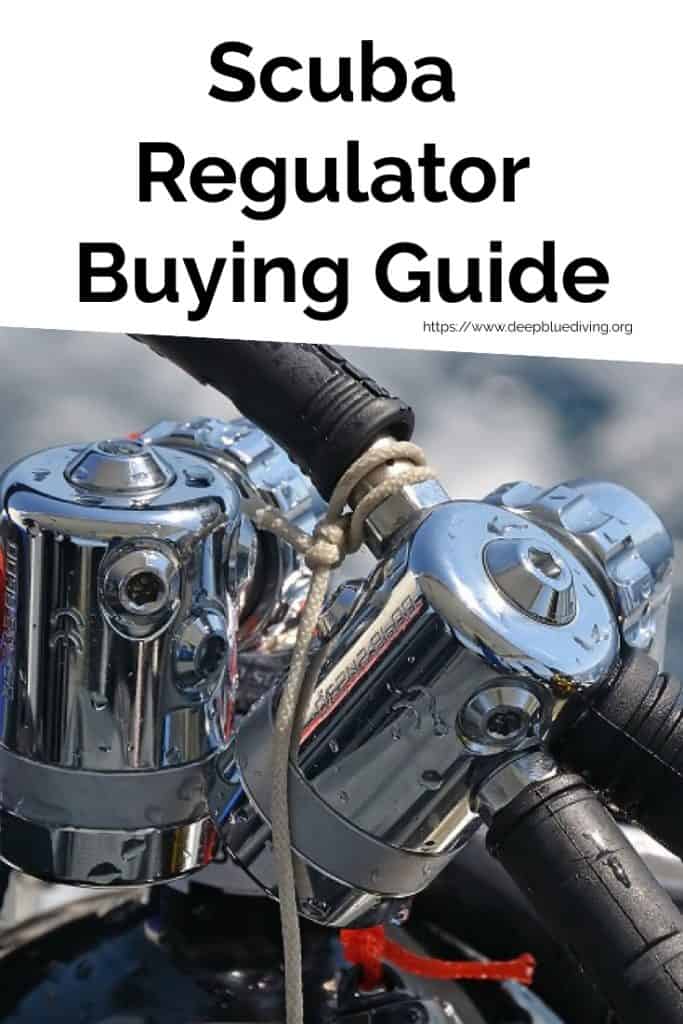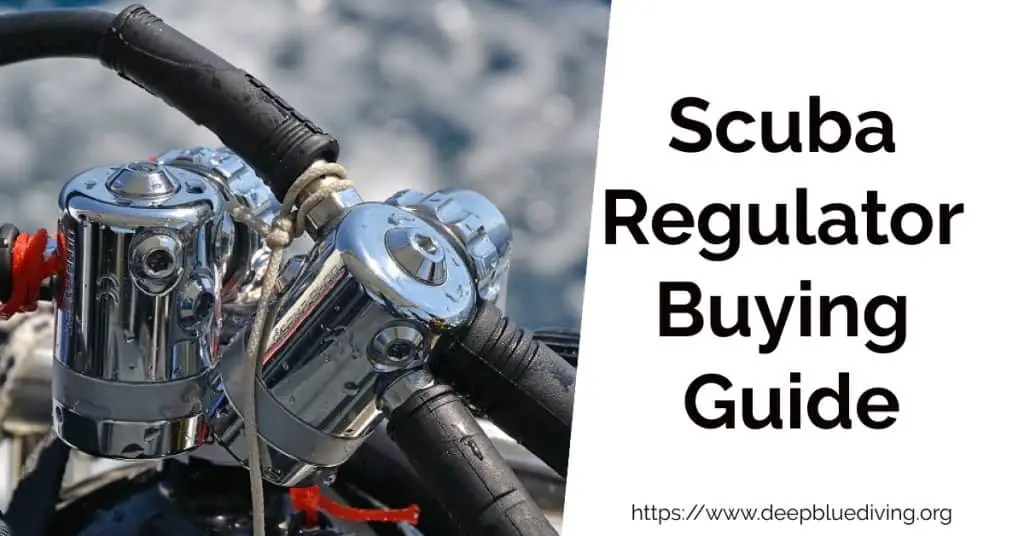Scuba Regulator Buying Guide – What do you need to know!
A lot of scuba gear is very technical and the most technical of them all are your scuba regulators. Well, besides your personal diving computer that is.
Your regulator should also be one of the first pieces of scuba gear you purchase.
Why you ask?
Well, how do you feel about using a mouthpiece that others have used and you have no idea who that might have been? Yes, it’s been cleaned but… Continue to find out what else you need to know before you get a reg in our scuba regulator buying guide!
It’s also essential as one of your first items to get simply because it’s the part of your gear that allows you to breathe. As that’s very important underwater, you might consider it your possibly most important piece of scuba gear overall! And, as it does allow you to breathe underwater, you want to make sure you get a good piece of equipment and that you maintain it to keep it in good shape!
This buying guide will educate you on the different pieces of your regulator. These are the first and second stages, the octo and the hoses. Lastly, we’ll quickly touch on the different gauge options you have to control your air use and what you have left.
You will usually purchase your first and second stage regulators as a package. That makes sense as you want those two pieces to match and work flawlessly with each other! You’ll know exactly what to buy when you’re through with this guide.
First Stage
The first stage of a regulator for scuba diving is designed to reduce the air pressure from the tank into a more manageable pressure that can be used in flexible hoses. This pressure level is called intermediate pressure.
The Scubapro MK25 First Stage scuba regulator is shown below. It’s an excellent example of a first stage regulator. Click below to check out what customers have to say about it.
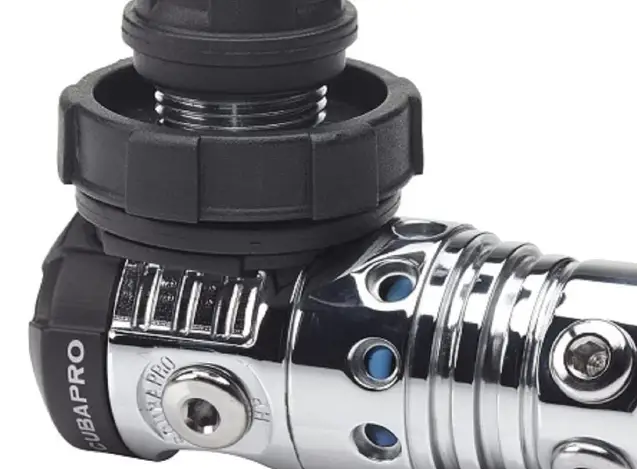
It is attached directly to the valve on the tank. Your tank has the air or gas mix under high pressure and the first stage regulates that pressure going into the hose right after that. The first stage is also the point where you attach your gauge for air pressure or your wireless air transmitter for your dive computer as well as your BC and octo!
There are some differences in the first stages when you’re looking to buy. Here’s an overview of what you have to consider and what the different options mean for you.
DIN vs. Yoke
Your first consideration is the type of how you attach your first stage to your tank. Many regulators are available as either DIN or yoke.
We have a whole article highlighting the differences between DIN and Yoke. There should be no questions unanswered after you’ve read that post.
DIN Regulators
A DIN first stage screws directly into the tank valve. This is the safest way to connect your first stage to a tank valve. Not only does it sit safely due to being screwed into the tank valve but it also restricts any movement of the O-ring seal that prevents air from escaping. This system is mostly used by technical divers as it can handle higher tank pressures.
Yoke Regulators
The yoke system is somewhat simpler but fully sufficient for recreational diving. In this setup, the regulator is slipped over the top of the valve and then secured and held in place with a large bolt. It’s somewhat easier to handle and safe to use in recreational diving.
Most tanks that you can rent will have a yoke attachment. A DIN regulator requires a compatible tank and not all dive shops have them. However, if you have a DIN regulator you can get a simple and low-cost adapter to convert it to a yoke system if the tank does not allow to use a DIN regulator.
You definitely want to purchase such a converter if you opt to buy a DIN regulator. You might otherwise find out the hard way that the available tanks in the dive shop will be of no use to you!
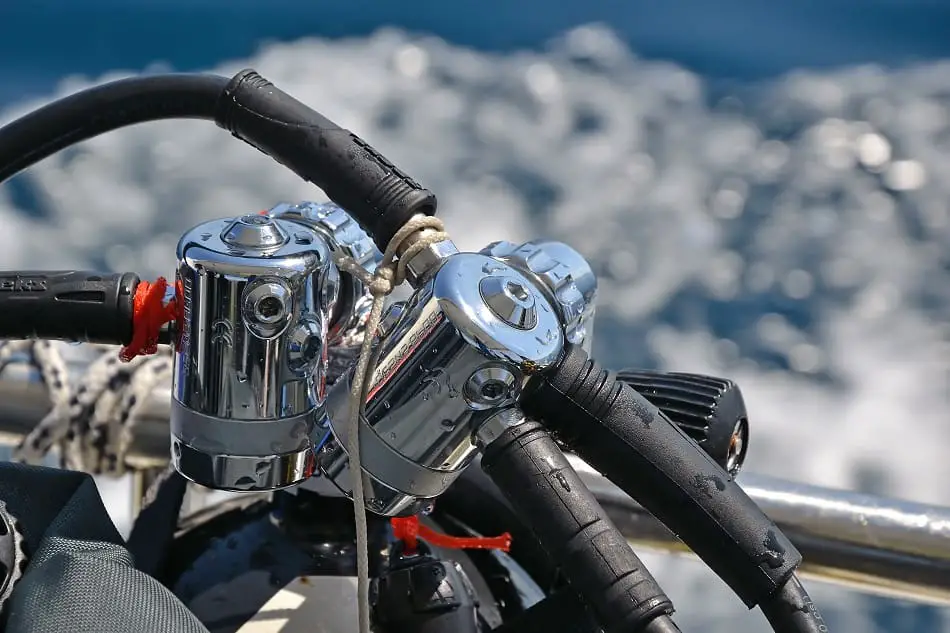
Balanced vs. Unbalanced
In the past, you had a pretty significant difference in performance between these two types of systems. In the meantime, most of these differences have been minimized and most (recreational) divers cannot distinguish once they’re underwater.
Balanced Scuba Diving Regulator
The difference is simply in how they work and how much they cost. A balanced regulator delivers the air at a constant pressure to the second stage and the diver. It is in no way affected by the pressure of the water surrounding you or the pressure of the air in the tank itself!
Unbalanced Regulator
An unbalanced system relies on the surrounding pressure as well as the pressure inside the tank. Modern unbalanced systems minimize those effects and you barely notice a difference.
Having said that, most divers prefer a balanced setup if they can afford it. Otherwise, opt for a high-quality unbalanced type and you’ll barely notice a difference in recreational dive environments.
What are the differences between Balanced and Unbalanced Regulators?
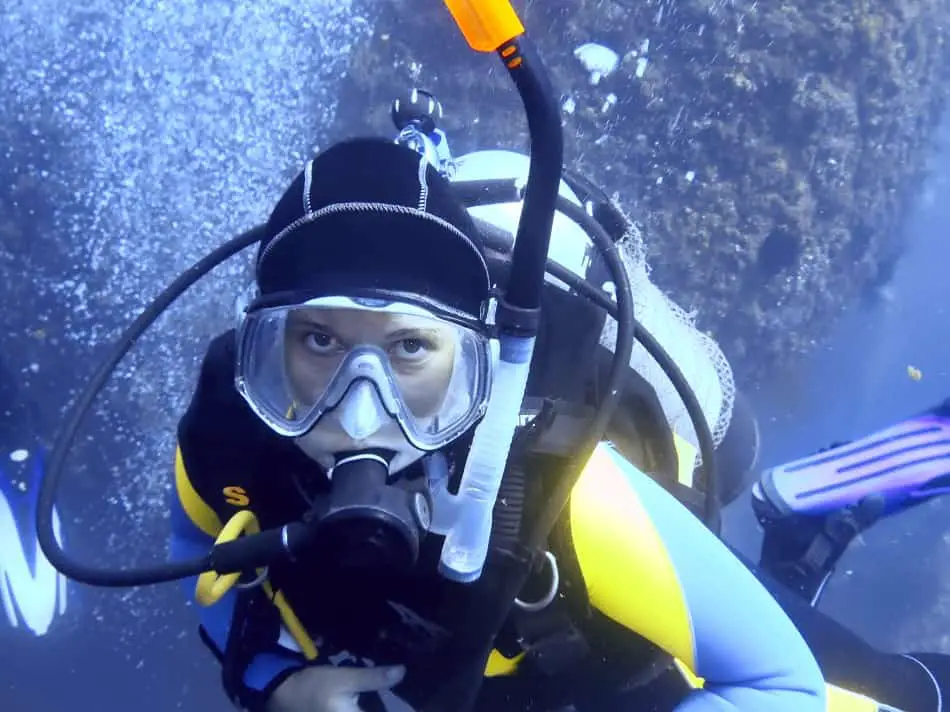
Diaphragm vs. Piston
Yet again there are two different types of setups that are used to connect the high-pressure air into lower pressure for the demand valve and other attachments. Both setups work fine for most recreational diving.
Piston Regulators
Piston regulators are overall simpler as they have a minimal amount of moving parts. This enhances durability and reduces maintenance costs. However, most of these first-stage regulators allow water into them and as such you have a higher level of care after a dive to keep them clean and prevent corrosion.
Diaphragm Regulators
Diaphragm regulators have more moving components and usually are not as durable as piston regulators. However, they are much cheaper to manufacture which usually results in a lower price for you.
You also want to think about getting a diaphragm regulator when you’re diving in cold water. Cold water can get your reg to freeze and usually a diaphragm reg is better in those conditions.
Environmentally Sealed or Unsealed First Stage
They come in two different flavors. You can get them either as environmentally sealed or unsealed. If you only dive in the tropics then an unsealed regulator is perfectly fine. If you want to mix up your dive environments and at times dive in cold water then you’re better off using an environmentally sealed setup.
For a recreational diver, it makes the most sense to look for an environmentally sealed first stage diaphragm regulator that has a long warranty. Also, make sure to use a well-known brand so you know you can get spare parts if needed!
Click for an in-depth comparison of Piston Regulator vs Diaphragm Regulator
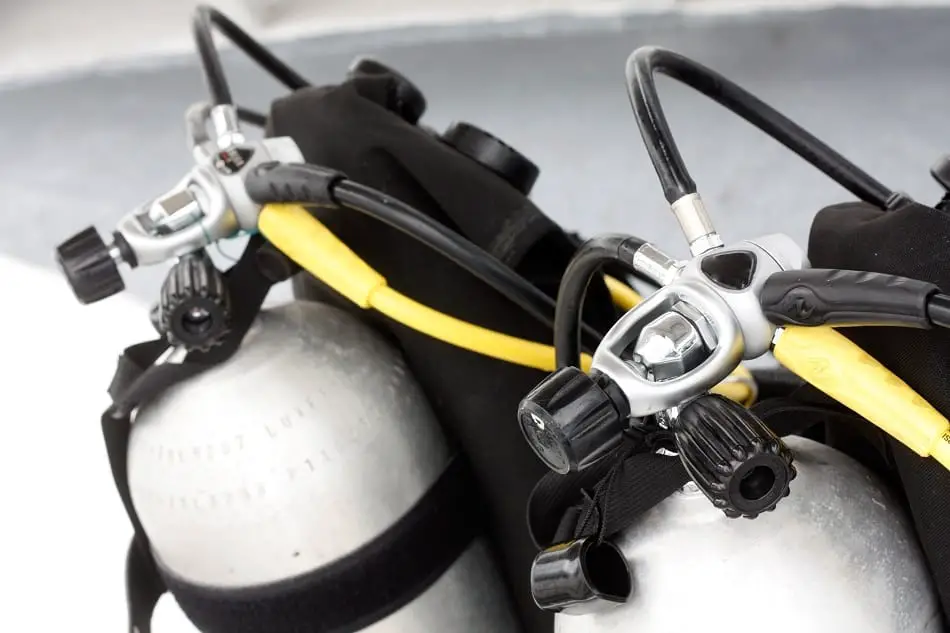
Number of Connection Ports
Most modern first stage regulators will have enough ports to allow you to connect your demand valve, your gauge or computer, and your BCD as well as a port for the octopus regulator if needed.
You’ll find high- and low-pressure ports on the 1st stage to connect your various gear. Your 2nd stage connects to get high-pressure air for breathing.
If you dive with a dry suit or need more ports to connect additional accessories and devices then you have to make sure that your first stage has enough ports to handle everything you want to connect!
Second Stage
The second stage, also known as the demand valve, is the piece of the setup that you have in your mouth, and that allows you to breathe. You’ll often see that this second stage is referred to as the regulator. It takes the air from the first stage (through a hose) and reduces the pressure so you can comfortably breathe.
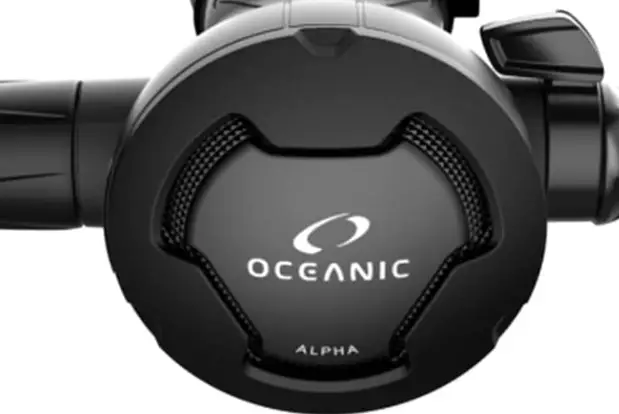
Similar to the first stage you can either have a diaphragm or piston setup in your demand valve. Your 2nd stage also has a purge button, a mouthpiece, and an exhaust valve.
The purge button allows you to clear any water from the setup. The exhaust valve allows your exhaled air to escape and finally the mouthpiece allows you to keep the regulator securely in your mouth without having to hold on to it.
But there are additional things to consider and look for when you’re looking at the second stage.
Purge Button
The purge button is there to allow you to clear your regulator. Pressing it forces the water out of the demand valve so you can breathe easily.
Large Purge Button for use with Gloves
You want to make sure that your regulator has a large enough purge button so that you can conveniently press it when needed. If the button is too small then you might have to fumble trying to press it if you’re wearing dive gloves.
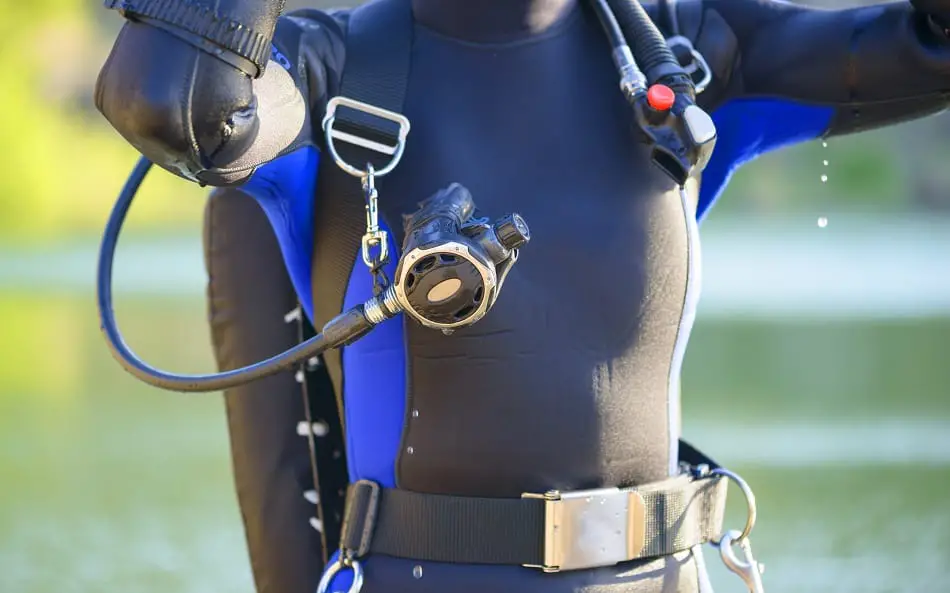
Controls
You can often find a number of controls on your regulator.
Regulating and Fine-Tuning Airflow
First, you can have the possibility to adjust the airflow so you can fine-tune the amount of air being delivered for your breathing. This is helpful when you dive deeper as it allows you to make sure that you can comfortably breathe.
Switch into Dive Mode to save Air
Another adjustment that is commonly found is to be able to set the regulator into ‘dive mode’. If you switch this mode off while you’re above the surface then it prevents air to free flow. It’s harder to breathe in that case but you’re not wasting air.
These adjustment controls are in most circumstances ‘nice-to-have’ features that you can live without especially if you’re recreationally diving.
Weight
The weight of the demand valve can be of importance to you. It’s the piece of equipment that you hold with your mouth and teeth and it can over time cause fatigue of the jaw.
Neutral Buoyancy of the Second Stage Regulator
Overall, the second stage is of neutral buoyancy and as such, the weight underwater should be of limited concern. However, above water, a heavy regulator can be somewhat tedious to wear and deal with.
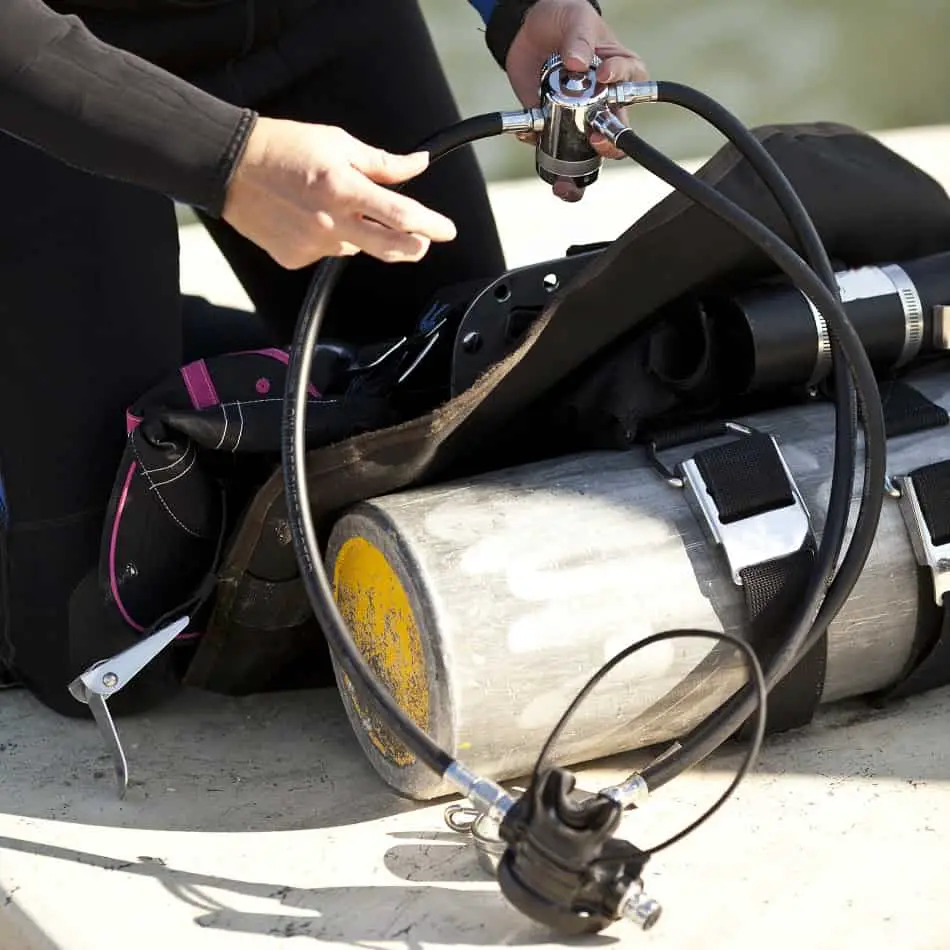
Mouth Piece
The mouthpiece must fit comfortably. Most modern second stage regulators have ergonomically shaped mouthpieces and as such, you should be fine.
Repair or Change the Mouthpiece on the Regulator
For repairs you want the mouthpiece to be replaceable. This is pretty much true for all new scuba regulators but you have to have a look at how the mouthpiece connects to the rest of the hardware. You can find proprietary mounting options or zip ties. In any case, you want to make sure you have the right spare parts in your repair kit!
Octopus Regulator
The octopus is nothing else than a spare or alternate second stage regulator. It is used to allow your dive buddy to breathe if he or she runs out of air or if your demand valve fails for whatever reason.
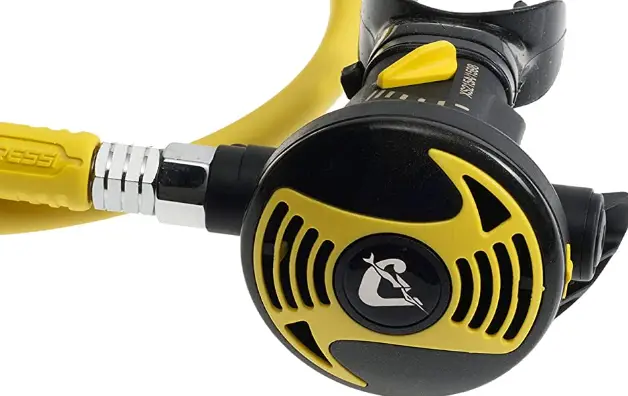
These octo regulators are only to be used as a backup and as such are usually less complex and of simpler design as your primary second stage regulator. In a typical dive setting, you will never use your octo as it’s only there for emergencies.
Bright Coloring for the Octo
Dive standards do require that the octo is easily accessible and clearly visible. Most octos are bright in color to make them stand out and to be easily identifiable. Most of today’s BCD’s also have a pocket to store the octo for easy access in case of an emergency.
If you want to read more about Octo regulators and which different kinds there are, then please check out our post on that: https://www.deepbluediving.org/scuba-octopus-regulators/
Maintenance Considerations for the Octopus
One of the things that is easily overseen with octo regulators is that they require the same care and maintenance as your other scuba gear. Make sure to keep your octo clean and perform all pre-dive and post-dive checks and maintenance steps that you also perform on your standard demand valve!
Hoses
Your regulator setup not only consists of the second and first stage, but also comes with a bunch of different hoses to connect both stages as well as additional accessories.
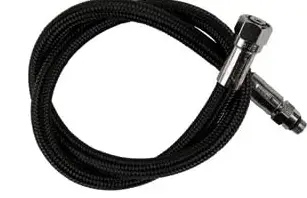
Hose to Connect First and Second Stage
This is usually a medium pressure hose that is used to connect the two stages. For many years the only available option you had was a rubber hose.
Braided Hoses last longer and are lighter than Rubber ones
In the last few years many manufacturers started to provide braided hoses. However, there have been a few instances where these types of hoses had to be recalled and as such divers today still tend to prefer a rubber hose.
A braided hose has some advantages though. They are usually lighter and more flexible and as such more convenient to deal with. A new braided hose should also be more durable than a rubber hose.
Inflation Hoses for Regulating the BCD
This type of hose connects the first stage to your BCD. You’ll need this link in order to be able to regulate your buoyancy through your BCD. You can either get a rubber hose or braided hoses which are lightweight and bendable.
Some BCD’s come with an octo regulator built into the inflator. In that case, you will usually require a special connector. You want to be aware of that when ordering your hoses.
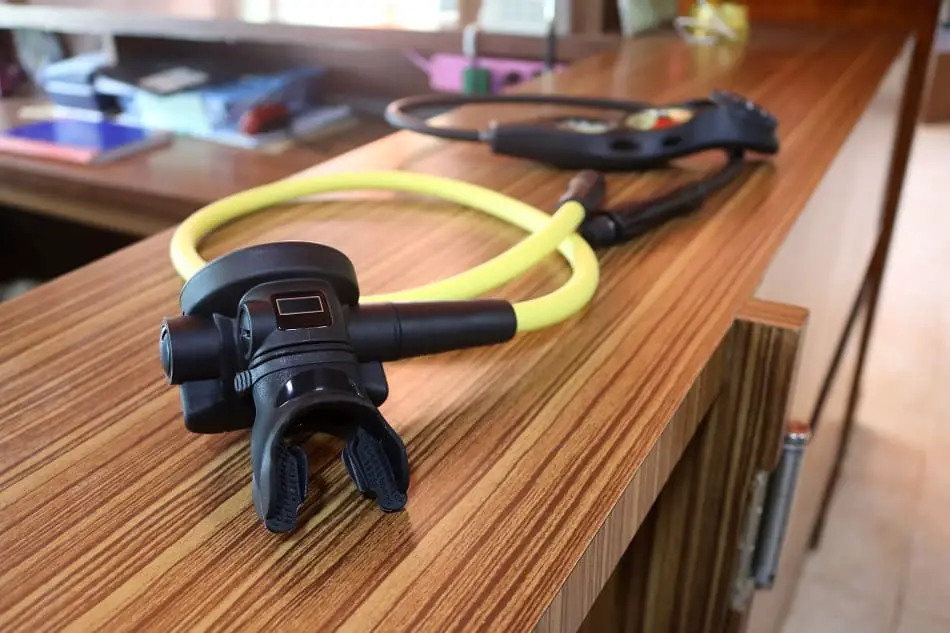
Hoses for Gauges and/or Dive Computer
You will usually have at least one gauge to monitor your tank pressure. Some divers prefer to use an analog gauge as well as a dive computer with air integration to monitor the pressure in their tank.
High-Pressure hoses for monitoring Tank pressure – Or use wireless Air-Integration instead?
These hoses are usually high-pressure hoses. If you’re choosing an air-integrated dive computer that has a wireless setup then your pressure monitor will sit directly on the first stage and wirelessly send the data to your dive computer.
However, many scuba divers prefer to have a console or gauge and not the wireless air integration of modern dive computers. In this case a high-pressure hose needs to be connected to one of the HP ports on the first stage and then connect to the gauge.
Wireless air integration is getting more common but is usually not (yet) found on entry-level dive computers. This will save you from dealing with yet another hose. However, it does make some divers uneasy to think of a non-mechanical way to measure how much air is left!
Conclusion
Most of the well-known brands will have regulator setups that are sufficient for any recreational diver. If you can then spend a few extra bucks to get a setup of the highest quality.
If you get the first stage with a DIN connector then make sure that you do purchase an adapter to make it usable with a yoke connector to ensure you won’t have to watch your buddies dive while you stay on land!
